
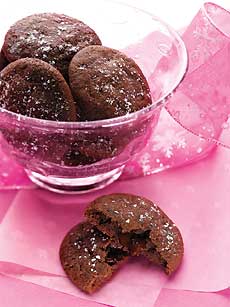
These molten lava cookies have a liquid chocolate center, just like lava cake. See the recipe. from the Wisconsin Milk Marketing Board.
July 2010
Last Updated January 2022
|
 |
Cookie Varieties
Page 5: Lebkuchen & Other Cookie Types I To L
This page contains cookie varieties beginning with the letters I to L, including ladyfinger, lebkuchen, and Linzer cookie. You can also see the overview of the different types of cookies and the history of cookies—how baked delights came to be. See our 100 other food glossaries—especially the Cake Glossary and Pastry Glossary.
There are thousands of different cookies in the world. This glossary’s objective is to highlight those found in the U.S. Please use the Contact Us link to report any missing entries.
Click on a letter to go to the appropriate glossary section.
a b c d e f g h i j k l m n o p q r s t u v w x y z
This glossary is protected by copyright and cannot be reproduced in whole or part.
You are welcome to link to it.
ICE BOX COOKIE
See refrigerator cookie.
ICING
Cookie icings include fondant, glace or glaze, and royal icing. See individual listings.
ITALIAN COOKIE
The best-known varieties of Italian cookies include amaretti, anginetti (Italian lemon drop cookies), baci, biscotti, canali, farfelette (fried bow ties), milan cookies (butter cookie sandwiches with chocolate filling), pignoli, pizzelle, savoiardi (ladyfingers—see below), sesame cookies, quarisimali (almond biscotti), rum balls, wedding love knots, and wine ring cookies.
KIPFEL
Kipfel is a Hungarian sibling of rugelach, a filled, horn-shaped filled cookie or roll. Common fillings are nuts and fruit preserves. There are many variations on the recipe, but most doughs include sour cream; some use cottage cheese.
KITCHEN SINK COOKIE
A chewy drop cookie with the “kitchen sink” of ingredients thrown in: chocolate chips, coconut, nuts, fruits, M&Ms, and anything else the baker wishes to include. A similar cookie that uses fewer inclusions is the cowboy cookie.
LACE COOKIE
See florentine.
LADYFINGER
Ladyfingers are very light sponge cakes that are finger-shaped with rounded ends (although no lady has such a fat, flat finger!). They have more flour, and are thus drier, than other sponges. Before baking, powdered sugar is sifted over the top to provide a soft crust and also a lighter cast to the final baked product. The cookies are three to four inches long and most popularly used as the cake component in charlottes, tiramisu and trifles, where they acquire moisture from the custard, cream or other components (they are soaked in coffee liqueur for tiramisu). Ladyfingers originated in the late 15th century at the court of the Duchy of Savoy, to celebrate a visit of the King of France. They were given the name savoiardi, “Savoyards.” (The House of Savoy, which began in northern Italy, eventually ruled the entire kingdom until the end of World War II.)
|
|
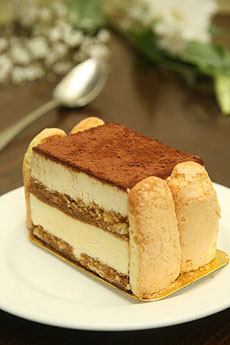
Ladyfingers are eaten as cookies as well as used to supporting charlottes and this tiramisu cake from FinancierPastries.com. |
Ladyfingers are also called boudoir biscuits, Naples biscuits, Savoy biscuits (savoiardi), sponge biscuits and sponge fingers; in French they are known as biscuits a la cuiller (coffee spoon or teaspoon biscuits).
LAVA COOKIE
A chocolate cookie with a molten center; a riff on the chocolate lava cake. See the photo at the top of the page.
LEBKUCHEN
The German word for gingerbread actually refers to a softer form of gingerbread than the crispy gingerbread cookie. The cookies are also called Pfefferkuchen, pepper cookies, a reference to the spiciness. Traditionally, the cookies are large, 4-1/2 inches in diameter with five-inch and larger rectangular dimensions. According to food historians, similar recipes can be dated to ancient Egypt, but the gingerbread made in medieval Germany is the first instance of “artistic” cookie design. It was crafted into fancy shapes and decorated by a professional guild of gingerbread makers, the Lebkuchner Guild, formed in 1643. The Guild ensured the quality control of gingerbread and limited the competition (only guild members could make and sell Lebkuchen). The only exceptions were during Christmas and Easter, when citizens were allowed to make their own Lebkuchen at home.
|
|
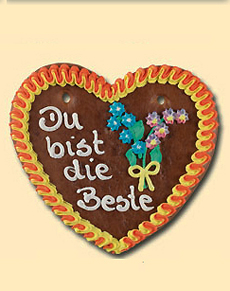
Lebkuchen can be custom-ordered with your message from Lebkuchengeschenke.de. This Valentine cookie says “You’re the best.” |
The city of Nürnberg (Nuremberg) was considered to have the finest Lebkuchen Guild; Lebkuchen was considered a gift worthy of heads of state and royalty. In the 17th century, gingerbread houses debuted, and ornate Lebkuchen began to be used as Christmas decorations. But as fancy as the cookies could be, there weren’t any gingerbread men in Germany. See gingerbread to see which monarch gets credit for inventing them. Today, Lebkuchen are made in the same ornate styles, although “everyday” small round ginger cookies, also called Lebkuchen (like our ginger snaps), are made for regular snacking—plain, chocolate-coated, iced, or sugar-dusted. Large but less ornate Lebkuchen, simply decorated with almonds or dried fruit, are consumed year-round. For the holidays, they are available shaped like fir trees and stars. The category has evolved into different varieties of Lebkuchen, including (but not limited to) Fine Elisen Lebkuchen, which contains at least 25% almonds or other nuts; Kaiserlein Lebkuchen, with pictures printed on the cookies; and White Lebkuchen (Weisse Lebkuchen), which resembles a regular cookie. “Nürnberger Lebkuchen” has been a protected domain of origin since 1927; Lebkuchen bearing the name must be produced within the city limits of Nürnberg.
Here’s more about Lebkuchen and its sister cookie, pfeffernüsse.
LE PETIT ÉCOLIER COOKIE
Produced by the French company LU (previously the Lefèvre-Utile Biscuit Co., today owned by Kraft Foods). The Little Schoolboy, as it is known in translation, is a butter cookie topped with a slab of chocolate; the chocolate is embossed with the image of a 19th-century schoolboy in knickers and high-button shoes. The original cookies had a semisweet chocolate bar. Today, this popular cookie is available in milk chocolate, semisweet chocolate, and bittersweet chocolate.
|
|
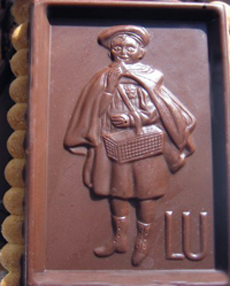
Le Petit Écolier cookie, the little schoolboy. Photo courtesy LU. |
LINZER COOKIE
A cookie version of the classic Austrian Linzertorte, created in the city of Linz. Raspberry jam is sandwiched between a nutty dough that has a soft, yet chewy consistency. The Linzer cookie is generally made in a fancy shape: round with crimped edges and a cutout center, or heart-shaped. Some are half-dipped in chocolate. Read the history of the Linzer cookie and discover our favorite Linzer cookie.
|
|
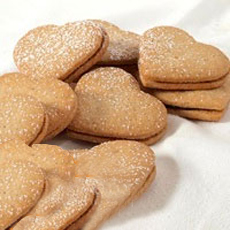
Linzer cookies from Sarabeth.com. |
Go To Next Page: Terms With M
Go To The Article Index Above
Lifestyle Direct, Inc. All rights reserved. Images are the copyright of their individual owners.

|








